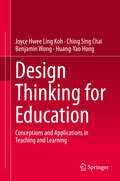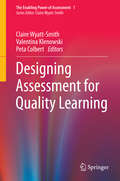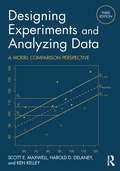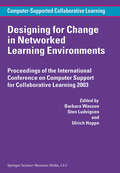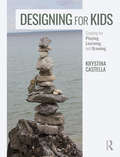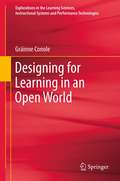- Table View
- List View
Design Thinking for Education: Conceptions and Applications in Teaching and Learning
by Joyce Hwee Koh Ching Sing Chai Benjamin Wong Huang-Yao HongThis book explores, through eight chapters, how design thinking vocabulary can be interpreted and employed in educational contexts. The theoretical foundations of design thinking and design in education are first examined by means of a literature review. This is then followed by chapters that characterize design thinking among children, pre-service teachers and in-service teachers using research data collected from the authors’ design-driven coursework and projects. The book also examines issues associated with methods for fostering and assessing design thinking. In the final chapter, it discusses future directions for the incorporation of design thinking into educational settings. Intended for teachers, teacher educators and university instructors, this book aims to provide them with the theoretical foundations needed to grasp design thinking, and to provide examples of how design thinking can be interpreted and evaluated. The materials covered will help these groups of professionals to consider how design thinking can be integrated into their own teaching and learning contexts. The book will also promote a discourse between educational researchers on the theoretical development of design thinking in educational settings.
Design your mind – Denkfallen entlarven und überwinden: Mit zielführendem Denken die eigenen Potenziale voll ausschöpfen
by Martin SauerlandDen Drang zum Perfektionismus, Schwarz-Weiß-Denken oder der ständige Vergleich mit anderen – wer kennt derartige Denkfallen nicht. Denkmuster dieser Art begegnen uns jeden Tag und beeinträchtigen unsere Denkprozesse und unsere Produktivität.In wissenschaftlichen Studien hat der Autor die häufigsten Denkfallen systematisch untersucht und beschrieben. Mit kurzen Selbsttests können diese schnell erkannt werden. Darauf aufbauend gibt er praktische Lösungswege an die Hand, mit denen die gelernten Denkmuster überwunden werden können. Eigene Potenziale werden so besser genutzt, die Entscheidungsqualität wird verbessert und die Toleranz für Belastungen steigt.
Design Your Mind! Denkfallen entlarven und überwinden: Mit zielführendem Denken die eigenen Potenziale voll ausschöpfen
by Martin SauerlandDas Denken in Schwarz-Weiß-Kategorien oder in Konjunktiven, übertriebener Perfektionismus oder der ständige Vergleich mit anderen – wer kennt derartige Denkfallen nicht. Denkmuster dieser Art begegnen uns jeden Tag und beeinträchtigen unsere Denkprozesse und unsere Produktivität.In wissenschaftlichen Studien hat der Autor die häufigsten Denkfallen systematisch untersucht und beschrieben. Mit kurzen Selbsttests können diese schnell erkannt werden. Darauf aufbauend gibt er praktische Lösungswege an die Hand, mit denen die gelernten Denkmuster überwunden werden können. Eigene Potenziale werden so besser genutzt, die Entscheidungsqualität wird verbessert und die Toleranz für Belastungen steigt.Dysfunktionale Denkstile wirken sich auch auf dysfunktionale Entscheidungsstile aus: Entscheidungen werden häufig zu lange aufgeschoben, auf andere Personen abgeschoben oder es wird impulsiv oder sogar defensiv entschieden. Darüber hinaus beeinflussen tief verwurzelte Glaubenssysteme zum Thema Geld, wie z.B. Schulden sind etwas Schlechtes, die Lebensführung vieler Menschen. Diese beiden Themenfelder wurden in der zweiten Auflage ergänzt.
Designing a Bottom-up Operations Strategy: Transforming Organizations and Individuals (SpringerBriefs in Operations Management)
by Thilo R. Scholz Arnd Huchzermeier Torsten A. KühlmannThis book focuses on top-down and bottom-up antecedents for employee engagement. It combines Operations Management (OM) with elements from Human Resource Management (HRM) and Organizational Behavior (OB) to answer the overarching question: “How is operations strategy formation influenced by the individual employee?” Dedicated chapters investigate key research questions, closing the integration gap between OM and HRM/OB. The book develops and statistically analyzes an operations strategy opportunity-motivation-ability framework. In addition, it examines how basic need fulfillment and organizational fairness relate to job satisfaction and performance. By doing so, the book helps readers to better understand employees’ preferences and enables operations managers to foster strategy-supportive behavior and job satisfaction more effectively in their workforces.
Designing and Implementing Effective Evaluations: Comprehensive Case Studies in Program Evaluation
by Steven D. Kniffley Kenneth J. LinfieldDesigning and Implementing Effective Evaluations provides extensive real-life examples of program evaluations that illustrate the various elements and steps in conducting a successful evaluation. The detailed and diverse range of case studies show the common elements, methods, approaches, and processes of program evaluations, while also demonstrating the way that good evaluators adapt and tailor those methods to the specific characteristics and needs of a given program. The chapters explore the process of problem solving while navigating multiple stakeholders, competing agendas, and varying environments. The book introduces conversations concerning how to adapt evaluation processes and concepts with culturally different individuals and communities. It discusses the role of culture in navigating a meaningful evaluation process when significant cultural differences exist between the evaluator and individuals that make up the organization. The text is a vital resource for postgraduate students in program evaluation courses in Psychology, Education, Public Health, Social Work and related fields.
Designing and Implementing Effective Evaluations: Comprehensive Case Studies in Program Evaluation
by Kenneth J. Linfield Steven KniffleyDesigning and Implementing Effective Evaluations provides extensive real-life examples of program evaluations that illustrate the various elements and steps in conducting a successful evaluation. The detailed and diverse range of case studies show the common elements, methods, approaches, and processes of program evaluations, while also demonstrating the way that good evaluators adapt and tailor those methods to the specific characteristics and needs of a given program. The chapters explore the process of problem solving while navigating multiple stakeholders, competing agendas, and varying environments. The book introduces conversations concerning how to adapt evaluation processes and concepts with culturally different individuals and communities. It discusses the role of culture in navigating a meaningful evaluation process when significant cultural differences exist between the evaluator and individuals that make up the organization. The text is a vital resource for postgraduate students in program evaluation courses in Psychology, Education, Public Health, Social Work and related fields.
Designing and Implementing Global Selection Systems (Talent Management Essentials #20)
by Ann G. Ryan Nancy T. TippinsDesigning and Implementing Global Selection Systems provides insights and essential management tools for planning and implementing an effective global staffing system. Provides the basic principles of employee selection and insights into the challenges of globally standardized selection systems Describes common pitfalls and the most effective best practice strategies for global staffing issues Includes helpful sidebars with examples to assist in making the best choices regarding selection system development and implementation
Designing and Leading a Successful SAR: A Guide for Sex Therapists, Sexuality Educators, and Sexologists
by Patti Britton Robert E. DunlapThis professional guidebook and training manual introduces the Sexual Attitudes Reassessment and Restructuring (SAR) training program for professionals working in the broad field of sexology. The authors, who have led 43 SAR training programs in seven different countries, provide an overview of the history and modern day context of SARs in the first part of the book. In Part II, they provide a toolkit for creating your own SAR, using 21 photocopiable workbook pages, handy checklists, and practical tips. Part III focuses on lessons learned from past SARs and future predictions for cutting-edge SARs. This book is necessary reading for clinicians and educators who wish to offer SAR training programs or integrate “The SAR Approach” into their practice.
Designing and Leading a Successful SAR: A Guide for Sex Therapists, Sexuality Educators, and Sexologists
by Patti Britton Robert E. DunlapThis professional guidebook and training manual introduces the Sexual Attitudes Reassessment and Restructuring (SAR) training program for professionals working in the broad field of sexology. The authors, who have led 43 SAR training programs in seven different countries, provide an overview of the history and modern day context of SARs in the first part of the book. In Part II, they provide a toolkit for creating your own SAR, using 21 photocopiable workbook pages, handy checklists, and practical tips. Part III focuses on lessons learned from past SARs and future predictions for cutting-edge SARs. This book is necessary reading for clinicians and educators who wish to offer SAR training programs or integrate “The SAR Approach” into their practice.
Designing and Reporting Experiments in Psychology (UK Higher Education OUP Psychology Psychology)
by Peter HarrisThis book will help undergraduate psychology students to write practical reports of experimental and other quantitative studies in psychology. It is designed to help with every stage of the report writing process including what to put in each section and recommendations for formatting and style. It also discusses how to design a study, including how to use and report relevant statistics. As such, the book acts both as an introduction and reference source to be used throughout an undergraduate course.Key features of the new edition include: New pedagogy. Website icons within the text reference an enhanced website, www.openup.co.uk/harris, and ‘Common Mistake’ icons highlight common errors students should avoid. Statistics icons make reference to two key statistics books* where students can find more detailed information. A further icon indicates the presence of relevant commentary at the end of the book for more advanced students Discussion of how to write up different forms of quantitative study and report relevant statistics Improved self-testing. There are diagnostic questions (with answers at the end of the book) as well as fifty self-assessment questions within the text to aid student learning. Chapters in part two contain a list of methodological and statistical concepts covered that will help students to consolidate their knowledge A completely revised section on how to find and cite references plus current information on how to cite electronic references, incorporating the new APA guidelines Advice on the ethics of conducting research on the Internet * The statistics books referenced are SPSS Survival Manual 3/e by Julie Pallant and Learning to Use Statistical Tests in Psychology 3/e by Judith Greene and Manuela d’Oliveira, both published by Open University Press. However, this book is designed for use with any statistics textbook.
Designing and Reporting Experiments in Psychology
by Peter Harris Jessica S. Horst Matthew J. EasterbrookThis book will help undergraduate psychology students to write practical reports of experimental and other quantitative studies in psychology. It is designed to help with every stage of report writing and provides a resource that students can refer to throughout their degree, up-to and including when writing up a final year undergraduate project.Now fully updated in its fourth edition, this book maps to the seventh edition of the APA guidelines and offers more comprehensive advice, guidelines and recommendations than ever before. Students will benefit from:•Coverage of different forms of quantitative study, including online studies and studies that use questionnaires, as well as experiments•A range of handy test yourself questions (with answers at the end of the book) •Self-reflection questions to prompt deeper understanding•Summary sections that articulate the main points and provide a useful revision aid•An Index of Concepts indicating where in the book every concept is introduced and defined•Updated advice on how to find and cite references •Expanded coverage of ethics in quantitative research, including how to write ethically•Common mistake symbols, flagging areas where its easy to be caught outPeter Harris is Emeritus Professor of Psychology at the University of Sussex, UK where he led the Social and Applied Psychology Group. He has taught research design and statistics for many years. He has published extensively in social and health psychology.Matthew J. Easterbrook is Senior Lecturer in Psychology at the University of Sussex, UK. He has taught statistics at a national and international level. Jessica S. Horst is Reader in Psychology at the University of Sussex, UK, where she is also the Director of Teaching and Learning. She has taught research methods in both the USA and the UK.
Designing Assessment for Quality Learning (The Enabling Power of Assessment #1)
by Claire Wyatt-Smith Valentina Klenowski Peta ColbertThis book brings together internationally recognised scholars with an interest in how to use the power of assessment to improve student learning and to engage with accountability priorities at both national and global levels. It includes distinguished writers who have worked together for some two decades to shift the assessment paradigm from a dominant focus on assessment as measurement towards assessment as central to efforts to improve learning. These writers have worked with the teaching profession and, in so doing, have researched and generated key insights into different ways of understanding assessment and its relationship to learning.The volume contributes to the theorising of assessment in contexts characterised by heightened accountability requirements and constant change. The book’s structure and content reflect already significant and growing international interest in assessment as contextualised practice, as well as theories of learning and teaching that underpin and drive particular assessment approaches. Learning theories and practices, assessment literacies, teachers’ responsibilities in assessment, the role of leadership, and assessment futures are the organisers within the book’s structure and content.The contributors to this book have in common the view that quality assessment, and quality learning and teaching are integrally related. Another shared view is that the alignment of assessment with curriculum, teaching and learning is linchpin to efforts to improve both learning opportunities and outcomes for all. Essentially, the book presents new perspectives on the enabling power of assessment. In so doing, the writers recognise that validity and reliability - the traditional canons of assessment – remain foundational and therefore necessary. However, they are not of themselves sufficient for quality education. The book argues that assessment needs to be radically reconsidered in the context of unprecedented societal change. Increasingly, communities are segregating more by wealth, with clear signs of social, political, economic and environmental instability. These changes raise important issues relating to ethics and equity, taken to be core dimensions in enabling the power of assessment to contribute to quality learning for all. This book offers readers new knowledge about how assessment can be used to re/engage learners across all phases of education.
Designing Democratic Schools and Learning Environments: A Global Perspective
by Linda F. Nathan Jonathan F. Mendonca Gustavo Rojas AyalaThis open access book explores democratic schools and learning environments globally. The book focuses on a newly developed framework for democratic education. The authors describe existing schools and concept schools—those that are ideas but not in operation. The first section includes the editors’ own journeys. Pillar 1 includes schools that emphasize the open flow of ideas and choices, regardless of their popularity. Pillar 2 maintains that it is impossible to have a high quality education that ignores equity. Chapters explore how many diverse ‘marginalized’ communities experience education and some innovations that hold great promise for inclusion. Pillar 3 provides examples of schools where active engagement, consensus and compromise support the ‘common good.’ Pillar 4 investigates schools which organize students, parents, social institutions and the larger community collaboratively to achieve its goals and to solve theirs and society’s most urgent challenges.
Designing Digital Experiences for Positive Youth Development: From Playpen to Playground
by Marina Umaschi BersBased on over a decade and a half of research, Designing Digital Experiences for Positive Youth Development aims to guide readers in the design of digital technologies to promote positive behaviors in children and teenagers.
Designing EEG Experiments for Studying the Brain: Design Code and Example Datasets
by Aamir Saeed Malik Hafeez Ullah AminDesigning EEG Experiments for Studying the Brain: Design Code and Example Datasets details the design of various brain experiments using electroencephalogram (EEG). Providing guidelines for designing an EEG experiment, it is primarily for researchers who want to venture into this field by designing their own experiments as well as those who are excited about neuroscience and want to explore various applications related to the brain. The first chapter describes how to design an EEG experiment and details the various parameters that should be considered for success, while remaining chapters provide experiment design for a number of neurological applications, both clinical and behavioral. As each chapter is accompanied with experiment design codes and example datasets, those interested can quickly design their own experiments or use the current design for their own purposes. Helpful appendices provide various forms for one's experiment including recruitment forms, feedback forms, ethics forms, and recommendations for related hardware equipment and software for data acquisition, processing, and analysis. - Written to assist neuroscientists in experiment designs using EEG - Presents a step-by-step approach to designing both clinical and behavioral EEG experiments - Includes experiment design codes and example datasets - Provides inclusion and exclusion criteria to help correctly identify experiment subjects and the minimum number of samples - Includes appendices that provide recruitment forms, ethics forms, and various subjective tests associated with each of the chapters
Designing Evidence-Based Public Health and Prevention Programs: Expert Program Developers Explain the Science and Art
by Mark E. FeinbergDemonstrating that public health and prevention program development is as much art as science, this book brings together expert program developers to offer practical guidance and principles in developing effective behavior-change curricula. Feinberg and the team of experienced contributors cover evidence-based programs addressing a range of physical, mental, and behavioral health problems, including ones targeting families, specific populations, and developmental stages. The contributors describe their own professional journeys and decisions in creating, refining, testing, and disseminating a range of programs and strategies. Readers will learn about selecting change-promoting targets based on existing research; developing and creating effective and engaging content; considering implementation and dissemination contexts in the development process; and revising, refining, expanding, abbreviating, and adapting a curriculum across multiple iterations. Designing Evidence-Based Public Health and Prevention Programs is essential reading for prevention scientists, prevention practitioners, and program developers in community agencies. It also provides a unique resource for graduate students and postgraduates in family sciences, developmental psychology, clinical psychology, social work, education, nursing, public health, and counselling.
Designing Evidence-Based Public Health and Prevention Programs: Expert Program Developers Explain the Science and Art
by Mark E. FeinbergDemonstrating that public health and prevention program development is as much art as science, this book brings together expert program developers to offer practical guidance and principles in developing effective behavior-change curricula. Feinberg and the team of experienced contributors cover evidence-based programs addressing a range of physical, mental, and behavioral health problems, including ones targeting families, specific populations, and developmental stages. The contributors describe their own professional journeys and decisions in creating, refining, testing, and disseminating a range of programs and strategies. Readers will learn about selecting change-promoting targets based on existing research; developing and creating effective and engaging content; considering implementation and dissemination contexts in the development process; and revising, refining, expanding, abbreviating, and adapting a curriculum across multiple iterations. Designing Evidence-Based Public Health and Prevention Programs is essential reading for prevention scientists, prevention practitioners, and program developers in community agencies. It also provides a unique resource for graduate students and postgraduates in family sciences, developmental psychology, clinical psychology, social work, education, nursing, public health, and counselling.
Designing Experiments and Analyzing Data: A Model Comparison Perspective, Third Edition
by Scott E. Maxwell Harold D. Delaney Ken KelleyDesigning Experiments and Analyzing Data: A Model Comparison Perspective (3rd edition) offers an integrative conceptual framework for understanding experimental design and data analysis. Maxwell, Delaney, and Kelley first apply fundamental principles to simple experimental designs followed by an application of the same principles to more complicated designs. Their integrative conceptual framework better prepares readers to understand the logic behind a general strategy of data analysis that is appropriate for a wide variety of designs, which allows for the introduction of more complex topics that are generally omitted from other books. Numerous pedagogical features further facilitate understanding: examples of published research demonstrate the applicability of each chapter’s content; flowcharts assist in choosing the most appropriate procedure; end-of-chapter lists of important formulas highlight key ideas and assist readers in locating the initial presentation of equations; useful programming code and tips are provided throughout the book and in associated resources available online, and extensive sets of exercises help develop a deeper understanding of the subject. Detailed solutions for some of the exercises and realistic data sets are included on the website (DesigningExperiments.com). The pedagogical approach used throughout the book enables readers to gain an overview of experimental design, from conceptualization of the research question to analysis of the data. The book and its companion website with web apps, tutorials, and detailed code are ideal for students and researchers seeking the optimal way to design their studies and analyze the resulting data.
Designing Experiments and Analyzing Data: A Model Comparison Perspective, Third Edition (The\inquiry And Pedagogy Across Diverse Contexts Ser.)
by Scott E. Maxwell Harold D. Delaney Ken KelleyDesigning Experiments and Analyzing Data: A Model Comparison Perspective (3rd edition) offers an integrative conceptual framework for understanding experimental design and data analysis. Maxwell, Delaney, and Kelley first apply fundamental principles to simple experimental designs followed by an application of the same principles to more complicated designs. Their integrative conceptual framework better prepares readers to understand the logic behind a general strategy of data analysis that is appropriate for a wide variety of designs, which allows for the introduction of more complex topics that are generally omitted from other books. Numerous pedagogical features further facilitate understanding: examples of published research demonstrate the applicability of each chapter’s content; flowcharts assist in choosing the most appropriate procedure; end-of-chapter lists of important formulas highlight key ideas and assist readers in locating the initial presentation of equations; useful programming code and tips are provided throughout the book and in associated resources available online, and extensive sets of exercises help develop a deeper understanding of the subject. Detailed solutions for some of the exercises and realistic data sets are included on the website (DesigningExperiments.com). The pedagogical approach used throughout the book enables readers to gain an overview of experimental design, from conceptualization of the research question to analysis of the data. The book and its companion website with web apps, tutorials, and detailed code are ideal for students and researchers seeking the optimal way to design their studies and analyze the resulting data.
Designing for Change in Networked Learning Environments (Computer-Supported Collaborative Learning Series #2)
by B. Wasson Sten Ludvigsen Ulrich HoppeThis volume is of interest to researchers and students, designers, educators, and industrial trainers in such disciplines as education, cognitive, social and educational psychology, didactics, computer science, linguistics and semiotics, speech communication, anthropology, sociology and design. It includes discussions on knowledge building, designing and analyzing group interaction, design of collaborative multimedia and 3D environments, computational modeling and analysis, and software agents.
Designing for Humans (Psychology at Work)
by Jan NoyesNature aside, the world in which we live should be designed for us, from everyday products like scissors and chairs to complex systems in avionics, medicine and nuclear power applications. Now more than ever, technological advances continue to increase the range and complexity of tasks that people have to perform. As a discipline, human factors psychology (ergonomics) therefore has an increasingly important role to play in ensuring that the human user's physical characteristics, cognitive abilities and social needs are taken into account in the development, implementation and operation of products and systems.In this book, Jan Noyes provides a comprehensive and up-to-date overview of human-machine interaction and the design of environments at work. Focusing on topics relevant to user-centred design, she includes coverage of the capabilities and limitations of humans, human-machine interactions, work environments, and organizational issues. Health and safety issues underpin a large amount of work on the human factors of design, and these are addressed fully throughout the book. Each chapter includes case studies that demonstrate the real-world relevance of the points being made and concludes with a list of key points.Although aimed primarily at advanced undergraduates, postgraduates and researchers in organizational and occupational psychology, this book will also be of relevance to students on engineering, computing and applied psychology/human factors programmes.
Designing for Humans (Psychology at Work)
by Jan NoyesNature aside, the world in which we live should be designed for us, from everyday products like scissors and chairs to complex systems in avionics, medicine and nuclear power applications. Now more than ever, technological advances continue to increase the range and complexity of tasks that people have to perform. As a discipline, human factors psychology (ergonomics) therefore has an increasingly important role to play in ensuring that the human user's physical characteristics, cognitive abilities and social needs are taken into account in the development, implementation and operation of products and systems.In this book, Jan Noyes provides a comprehensive and up-to-date overview of human-machine interaction and the design of environments at work. Focusing on topics relevant to user-centred design, she includes coverage of the capabilities and limitations of humans, human-machine interactions, work environments, and organizational issues. Health and safety issues underpin a large amount of work on the human factors of design, and these are addressed fully throughout the book. Each chapter includes case studies that demonstrate the real-world relevance of the points being made and concludes with a list of key points.Although aimed primarily at advanced undergraduates, postgraduates and researchers in organizational and occupational psychology, this book will also be of relevance to students on engineering, computing and applied psychology/human factors programmes.
Designing for Kids: Creating for Playing, Learning, and Growing
by Krystina CastellaDesigners, especially design students, rarely have access to children or their worlds when creating products, images, experiences and environments for them. Therefore, fine distinctions between age transitions and the day-to-day experiences of children are often overlooked. Designing for Kids brings together all a designer needs to know about developmental stages, play patterns, age transitions, playtesting, safety standards, materials and the daily lives of kids, providing a primer on the differences in designing for kids versus designing for adults. Research and interviews with designers, social scientists and industry experts are included, highlighting theories and terms used in the fields of design, developmental psychology, sociology, cultural anthropology and education. This textbook includes more than 150 color images, helpful discussion questions and clearly formatted chapters, making it relevant to a wide range of readers. It is a useful tool for students in industrial design, interaction design, environmental design and graphic design with children as the main audience for their creations.
Designing for Kids: Creating for Playing, Learning, and Growing
by Krystina CastellaDesigners, especially design students, rarely have access to children or their worlds when creating products, images, experiences and environments for them. Therefore, fine distinctions between age transitions and the day-to-day experiences of children are often overlooked. Designing for Kids brings together all a designer needs to know about developmental stages, play patterns, age transitions, playtesting, safety standards, materials and the daily lives of kids, providing a primer on the differences in designing for kids versus designing for adults. Research and interviews with designers, social scientists and industry experts are included, highlighting theories and terms used in the fields of design, developmental psychology, sociology, cultural anthropology and education. This textbook includes more than 150 color images, helpful discussion questions and clearly formatted chapters, making it relevant to a wide range of readers. It is a useful tool for students in industrial design, interaction design, environmental design and graphic design with children as the main audience for their creations.
Designing for Learning in an Open World (Explorations in the Learning Sciences, Instructional Systems and Performance Technologies #4)
by Gráinne ConoleThe Internet and associated technologies have been around for almost twenty years. Networked access and computer ownership are now the norm. There is a plethora of technologies that can be used to support learning, offering different ways in which learners can communicate with each other and their tutors, and providing them with access to interactive, multimedia content. However, these generic skills don’t necessarily translate seamlessly to an academic learning context. Appropriation of these technologies for academic purposes requires specific skills, which means that the way in which we design and support learning opportunities needs to provide appropriate support to harness the potential of technologies. More than ever before learners need supportive ‘learning pathways’ to enable them to blend formal educational offerings, with free resources and services. This requires a rethinking of the design process, to enable teachers to take account of a blended learning context.
